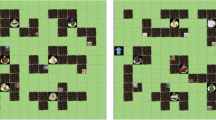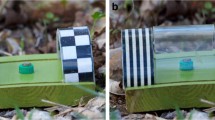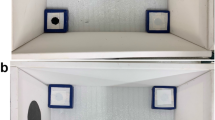Abstract
Previous studies in our laboratory have shown that when presented with a sudden stimulus simulating an oncoming predator, Mongolian gerbils can compute the optimal trajectory to a safe refuge, taking into account the position of the threat, the location of a clearly visible refuge, and several other contextual variables as well. In the present studies, the main goal was to explore the abilities of gerbils to use mental representations of spaces that were visually occluded by opaque barriers to compute efficient escape trajectories. In all studies, gerbils were placed into a round open field containing a single refuge. On each trial, an overhead visual stimulus was caused to ‘fly’ overhead, eliciting robust escape movements from the gerbils. By manipulating the shape and position of a series of opaque barriers that were interposed between the gerbils and the refuge, we were able to show that gerbils can compute the shortest route to an invisible target, even when the available routes to the target are made complex by using elaborate barrier shapes. These findings suggest that gerbils can maintain representations of their locations with respect to salient environmental landmarks and refuges, even when such locations are not continuously visible.







Similar content being viewed by others
References
Ågren G (1976) Social and territorial behaviour in the Mongolian gerbil (Meriones unguiculatus) under seminatural conditions. Biol Behav 1:276–285
Ågren G, Zhou Q, Zhong W (1989) Ecology and social behaviour of Mongolian gerbils, Meriones unguiculatus, at Xilinhot, Inner Mongolia, China. Anim Behav 37:11–27
Bennett AG (1996) Do animals have cognitive maps? J Exp Biol 199(1):219–224
Chapuis N, Scardigl P (1993) Shortcut ability in hamsters (Mesocricetus auratus): the role of environmental and kinesthetic information. Learn Behav 21(3):255–265
Collett TS (1982) Do toads plan routes? A study of the detour behaviour of Bufo viridis. J Comp Physiol A 146(2):261–271
Collett TS, Harkness LIK (1982) Depth vision in animals. In: Ingle DJ, Goodale MA, Mansfield RJW (eds) Analysis of visual behavior. MIT Press, Cambridge, pp 111–176
Clark MM, Galef BB (1979) A sensitive period for the maintenance of emotionality in Mongolian gerbils. J Comp Physiol Psychol 93:200–210
Eilam D, Golani I (1989) Home base behavior of rats (Rattus norvegicus) exploring a novel environment. Behav Brain Res 34(3):199–211
Ellard CG (1993) Organization of escape movements from overhead threats in the Mongolian gerbil (Meriones unguiculatus). J Comp Psychol 107(3):242–249
Ellard C (1996) Laboratory studies of antipredator behavior in the Mongolian gerbil (Meriones unguiculatus): factors affecting response attenuation with repeated presentations. J Comp Psychol 110(2):155–163
Ellard CG, Goodale MA (1988) A functional analysis of the collicular output pathways: a dissociation of deficits following lesions of the dorsal tegmental decussation and the ipsilateral colliculus efferent bundle in the Mongolian gerbil. Exp Brain Res 71(2):307–319
Ellard CG (2008) You are here. Doubleday, New York (in press)
Ellard CG, Shankar S (2001) Distance computation and spatial navigation in the gerbil: a comparison of contributions from open and closed loop movement control. In: Chen L, Zhuo Y (eds) Proceedings of the third international conference on cognitive science, Press of University of Science and Technology of China, Beijing, pp 29–34
Fiset S, Doré FY (1996) Spatial encoding in domestic cats (Felis catus). J Exp Psychol Anim Behav Process 22(4):420–437
Gallistel CR (1993) The organization of learning. MIT Press, Cambridge
Goodale MA (1983) Neural mechanisms of visual orientation in rodents: targets versus places. In: Hein A, Jeannerod M (eds) Spatially oriented behavior. Springer, Heidelberg, pp 35–62
Hemmi JM (2004) Predator avoidance in fiddler crabs: 1. Escape decisions in relation to the risk of predation. Anim Behav 69(3):603–614
Healey S (1998) Spatial representation in animals. Oxford University Press, Oxford
Howland HC (1974) Optimal strategies for predator avoidance: the relative importance of speed and manoevrability. J Theoret Biol 47:333–350
Kramer DL, Bonenfant M (1997) Direction of predator approach and the decision to flee to a refuge. Anim Behav 54:289–295
Menzel R, Gregger U, Smith A, Berger S, Brandt R, Brunke S, Bundrock G, Hülse S, Plümpe T, Schaupp F, Schüttler E, Stach S, Stindt J, Stollhoff J, Watzl S (2005) Honeybees navigate according to a map-like spatial memory. Proc Natl Acad Sci USA 102(8):3040–3045
Müller M, Wehner R (1988) Path integration in desert ants, Cataglyphis fortis. Proc Natl Acad Sci USA 85(14):5287–5290
Rydell J, Skals N, Surlykke A, Svenson M (1997) Hearing and bat defence in geometrid winter moths. Proc R Soc Lond B 254:83–88
Sherry DF (1998) The ecology and neurobiology of spatial memory. In: Dukas R (ed) Cognitive ecology. The University of Chicago Press, Chicago, pp 261–296
Tarsitano MS, Andrew R (1999) Scanning and route selection in the jumping spider Portia labiata. Anim Behav 58(2):255–265
Tchernichovski O, Benjamini Y, Golani I (1998) The dynamics of long-term exploration in the rat. Part I. A phase-plane analysis of the relationship between location and velocity. Biol Cybern 78(6):423–432
Thinus-Blanc C (1996) Animal spatial cognition: behavioural and brain approaches. World Scientific, Hackensack
Tolman EC (1948) Cognitive maps in rats and men. Psychol Rev 55:189–208
Wang RF, Spelke E (2002) Human spatial representation: insights from animals. Trends Cogn Sci 6(9):376–382
Ydenberg RC, Dill LM (1986) The economics of fleeing from predators. Adv Study Behav 16:229–249
Author information
Authors and Affiliations
Corresponding author
Rights and permissions
About this article
Cite this article
Ellard, C.G., Eller, M.C. Spatial cognition in the gerbil: computing optimal escape routes from visual threats. Anim Cogn 12, 333–345 (2009). https://doi.org/10.1007/s10071-008-0193-9
Received:
Revised:
Accepted:
Published:
Issue Date:
DOI: https://doi.org/10.1007/s10071-008-0193-9




